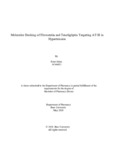| dc.contributor.advisor | Siam, Mohammad Kawsar Sharif | |
| dc.contributor.author | Jahan, Esrat | |
| dc.date.accessioned | 2020-08-06T14:28:48Z | |
| dc.date.available | 2020-08-06T14:28:48Z | |
| dc.date.copyright | 2019 | |
| dc.date.issued | 2019-05 | |
| dc.identifier.other | ID 14346021 | |
| dc.identifier.uri | http://hdl.handle.net/10361/13913 | |
| dc.description | This thesis is submitted in partial fulfilment of the requirements for the degree of Bachelor of Pharmacy, 2019. | en_US |
| dc.description | Cataloged from PDF version of thesis report. | |
| dc.description | Includes bibliographical references (pages 49-56). | |
| dc.description.abstract | Hypertension, or high blood pressure is a major risk factor causing cardiovascular diseases such as cerebrovascular stroke and ischemic heart disease. It is now considered as one of the most common disease and over 1.13 billion people are suffering from hypertension all over the world. The protein AT1R (octapeptide receptor that belongs to class A GPCR) plays an important role in vascular smooth muscle contraction and aldosterone secretion which results in hypertension. AT1R protein is responsible for developing hypertension via some biosynthetic pathways such as Ca/IP3 pathway. AT1 receptor antagonists have become the drug of choice for the patients who are suffering from hypertension and other cardiovascular disease by controlling overexpression of AT1 receptor. In this study, drug repurposing and other in silico computational methods have been used in order to find potential AT1R antagonists which will be used to inhibit and control the production of AT1R. PyRx, Discovery studio, Ramachandran plot and ProSa web server were used in this study. Initially over 160 small molecules were selected and docked with the AT1R protein based on binding affinity and stability ten potential drugs which were finally selected. The aim of this study was to find drugs which targeted and blocked AT1R to prevent its activation in order to control hypertension. The study shows that fluvastatin and teneligliptin have high binding affinities towards AT1R and could be used as anti-hypertensive drugs for hypertension by inhibiting the activation of AT1R. | en_US |
| dc.description.statementofresponsibility | Esrat Jahan | |
| dc.format.extent | 56 pages | |
| dc.language.iso | en | en_US |
| dc.publisher | Brac University | en_US |
| dc.rights | Brac University theses are protected by copyright. They may be viewed from this source for any purpose, but reproduction or distribution in any format is prohibited without written permission. | |
| dc.subject | Angiotensin receptor | en_US |
| dc.subject | Hypertension | en_US |
| dc.subject | Drug repurposing | en_US |
| dc.subject | Molecular docking | en_US |
| dc.subject | Drug-protein interaction | en_US |
| dc.subject.lcsh | Heart--Diseases | |
| dc.title | Molecular docking of Fluvastatin and Teneligliptin targeting AT1R in hypertension | en_US |
| dc.type | Thesis | en_US |
| dc.contributor.department | Department of Pharmacy, Brac University | |
| dc.description.degree | B. Pharmacy | |

